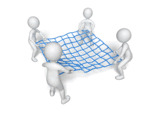 “Take the bull by the horns” is a phrase that is often heard in Improvement circles.
“Take the bull by the horns” is a phrase that is often heard in Improvement circles.
The metaphor implies that the system – the bull – is an unpredictable, aggressive, wicked, wild animal with dangerous sharp horns.
“Unpredictable” and “Dangerous” is certainly what the newspapers tell us the NHS system is – and this generates fear. Fear-for-our-safety and fear drives us to avoid the bad tempered beast.
It creates fear in the hearts of the very people the NHS is there to serve – the public. It is not the intended outcome.
“Bullish” is a phrase we use for “aggressive behaviour” and it is disappointing to see those accountable behave in a bullish manner – aggressive, unpredictable and dangerous.
We are taught that bulls are to be avoided and we are told to not to wave red flags at them! For our own safety.
But that is exactly what must happen for Improvement to flourish. We all need regular glimpses of the Red Flag of Reality. It is called constructive feedback – but it still feels uncomfortable. Our natural tendency to being shocked out of our complacency is to get angry and to swat the red flag waver. And the more powerful we are, the sharper our horns are, the more swatting we can do and the more fear we can generate. Often intentionally.
So inexperienced improvement zealots are prodded into “taking the executive bull by the horns” – but it is poor advice.
Improvement Scientists are not bull-fighters. They are not fearless champions who put themselves at personal risk for personal glory and the entertainment of others. That is what Rescuers do. The fire-fighters; the quick-fixers; the burned-toast-scrapers; the progress-chasers; and the self-appointed-experts. And they all get gored by an angry bull sooner or later. Which is what the crowd came to see – Bull Fighter Blood and Guts!
So attempting to slay the wicked bullish system is not a realistic option.
What about taming it?
This is the game of Bucking Bronco. You attach yourself to the bronco like glue and wear it down as it tries to throw you off and trample you under hoof. You need strength, agility, resilience and persistence. All admirable qualities. Eventually the exhausted beast gives in and does what it is told. It is now tamed. You have broken its spirit. The stallion is no longer a passionate leader; it is just a passive follower. It has become a Victim.
Improvement requires spirit – lots of it.
Improvement requires the spirit-of-courage to challenge dogma and complacency.
Improvement requires the spirit-of-curiosity to seek out the unknown unknowns.
Improvement requires the spirit-of-bravery to take calculated risks.
Improvement requires the spirit-of-action to make the changes needed to deliver the improvements.
Improvement requires the spirit-of-generosity to share new knowledge, understanding and wisdom.
So taming the wicked bull is not going to deliver sustained improvement. It will only achieve stable mediocrity.
So what next?
What about asking someone who has actually done it – actually improved something?
Good idea! Who?
What about someone like Don Berwick – founder of the Institute of Healthcare Improvement in the USA?
Excellent idea! We will ask him to come and diagnose the disease in our system – the one that lead to the Mid-Staffordshire septic safety carbuncle, and the nasty quality rash in 14 Trusts that Professor Sir Bruce Keogh KBE uncovered when he lifted the bed sheet.
[Click HERE to see Dr Bruce’s investigation].
We need a second opinion because the disease goes much deeper – and we need it from a credible, affable, independent, experienced expert. Like Dr Don B.
So Dr Don has popped over the pond, examined the patient, formulated his diagnosis and delivered his prescription.
[Click HERE to read Dr Don’s prescription].
Of course if you ask two experts the same question you get two slightly different answers. If you ask ten you get ten. This is because if there was only one answer that everyone agreed on then there would be no problem, no confusion, and need for experts. The experts know this of course. It is not in their interest to agree completely.
One bit of good news is that the reports are getting shorter. Mr Robert’s report on the failing of one hospital is huge and has 209 recommendations. A bit of a bucketful. Dr Bruce’s report is specific to the Naughty Fourteen who have strayed outside the statistical white lines of acceptable mediocrity.
Dr Don’s is even shorter and it has just 10 recommendations. One for each finger – so easy to remember.
1. The NHS should continually and forever reduce patient harm by embracing wholeheartedly an ethic of learning.
2. All leaders concerned with NHS healthcare – political, regulatory, governance, executive, clinical and advocacy – should place quality of care in general, and patient safety in particular, at the top of their priorities for investment, inquiry, improvement, regular reporting, encouragement and support.
3. Patients and their carers should be present, powerful and involved at all levels of healthcare organisations from wards to the boards of Trusts.
4. Government, Health Education England and NHS England should assure that sufficient staff are available to meet the NHS’s needs now and in the future. Healthcare organisations should ensure that staff are present in appropriate numbers to provide safe care at all times and are well-supported.
5. Mastery of quality and patient safety sciences and practices should be part of initial preparation and lifelong education of all health care professionals, including managers and executives.
6. The NHS should become a learning organisation. Its leaders should create and support the capability for learning, and therefore change, at scale, within the NHS.
7. Transparency should be complete, timely and unequivocal. All data on quality and safety, whether assembled by government, organisations, or professional societies, should be shared in a timely fashion with all parties who want it, including, in accessible form, with the public.
8. All organisations should seek out the patient and carer voice as an essential asset in monitoring the safety and quality of care.
9. Supervisory and regulatory systems should be simple and clear. They should avoid diffusion of responsibility. They should be respectful of the goodwill and sound intention of the vast majority of staff. All incentives should point in the same direction.
10. We support responsive regulation of organisations, with a hierarchy of responses. Recourse to criminal sanctions should be extremely rare, and should function primarily as a deterrent to wilful or reckless neglect or mistreatment.
The meat in the sandwich are recommendations 5 and 6 that together say “Learn Improvement Science“.
And what happens when we commit and engage in that learning journey?
Steve Peak has described what happens in this this very blog. It is called the OH effect.
OH stands for “Obvious-in-Hindsight”.
Obvious means “understandable” which implies visible, sensible, rational, doable and teachable.
Hindsight means “reflection” which implies having done something and learning from reality.
So if you would like to have a sip of Dr Don’s medicine and want to get started on the path to helping to create a healthier healthcare system you can do so right now by learning how to FISH – the first step to becoming an Improvement Science Practitioner.
The good news is that this medicine is neither dangerous nor nasty tasting – it is actually fun!
And that means it is OK for everyone – clinicians, managers, patients, carers and politicians. All of us.
 It is surprising how competitive most people are. We are constantly comparing ourselves with others and using what we find to decide what to do next. Groan or Gloat. Chase or Cruise.
It is surprising how competitive most people are. We are constantly comparing ourselves with others and using what we find to decide what to do next. Groan or Gloat. Chase or Cruise.




